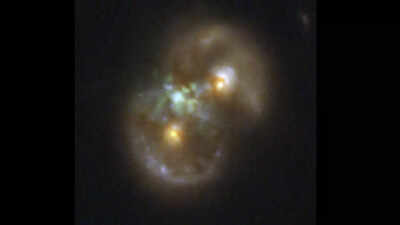The James webb space telescope Has made a groundbreaking discovery that May Reshape our undersrstanding of Supermassive Black HolesWhile Analysing data from the cosmos-veb survey, astronomers pieter van dokkum of yale university and gabriel brammer of the university of copenhagen identified a highly unusual galaxy, dubbed the Infinity galaxyAccording to Nasa Reports. Its distinctive shape, research the infinity symbol, is thought to have formed from the head-on collision of two disk galaxies. At the center of this cosmic oddity lies a supermassive black hole, positioned in an unexpected location, offering astronomers a rare glimpse into a posesible new Way Black Holes Can Form.
James Webb Space Telescope Reveals a Possible Direct Collapse Black Hole in the Infinity Galaxy
The infinity galaxy shows two compact, red nuclei, each surrounded by a ring of stars. When viewed at a 45-degree angle, the overlapping rings create an infinity symbol shape. What makes this galaxy remarkable is the presence of a supermassive black hole located between the two nuclei, embedded in a vast cloud of Glowing Gas. This unusual position has lad scientists to propose that the black hole may have formed through a process know as directed as directed, where a dense gas cloud collad colors Forming Stars First.The hubble-like images captured by jwst’s nircam (near-infrared camera) show light at 0.9 microns as blue, 1.15 and 1.5 microns as green, 2.0 microns as red. The two nuclei appear as bright yellow spots, while the Ionised Hydrogen Gas Between them Glows Green.
How the Black Hole Might Have Formed
The location of the black hole is unusual. It is not inside eater of the galactic nuclei, where supermassive black holes are typically found, but directly in the middle of the ionized gas. Pieter van dokkum explains, “Finding a black hole that’s not in the nucleus of a massive galaxy is unusual. Before. “There are two main theories for the formation of supermassive black hole:
- Light seed theory – Small Black Holes Form from collapsing stars. These small black holes Merge Over Time to Create Larger Ones. However, this process is slow and may not account for the extramely Massive Black Holes observed early in the university.
- Heavy seed theory – a Massive Black Hole Forms Directly from the Collapse of a Large Gas Cloud. This process can create a black hole with up to one million time the mass of the sun almost instantly. The challenge is that collapsing gas clouds typically form stars raather than black hole.
The Infinity Galaxy May Provide Evidence Supporting The Heavy Seed Theory. During the collision, the gas in the two Galaxies also ben compressed into a dens
Astronomers Detect Trio of Black Holes in Infinity Galaxy, Including a Possible Direct Collapse
Follow-up observations with other telescopes, such as nasa’s chandra x-ray observatorry and the very large array, confirm that the black hole is activating. Radio and X-Ray Data Show the Black Hole is Pulling in Surrounding Material, While The Velocity of the Gas Aligns with the Black Hole’s Motion, Suggesting it formed in place rather than eating era plate Different Galaxy.Interestingly, both of the galaxy’s nuclei also contain active supermassive black holes, making this system home to three confirmed Black Holes: Two in the Original Nuclei and One in the middle.
New insights on Black Holes from James Webb Space Telescope observations
Supermassive Black Holes Are Mysterious and Difential to Study, Especially that that formed in the Early Universe. The james webb space telescope has alredy identified Several Massive Black Holes that existed Too Soon for the Traditional Light Seed Formation to Explain. The infinity galaxy may provide a first look at a black hole forming via direct collaps, helping astronomers undersrstand the extrame physics involved.Dr ragadeepika pucha of the university of utah, who was not involved in the study, say, “If this black hole’s origin is proven, it’s the first step towards undersrstanding the direct-collectionsAlso read | 10 fascinating facts about the milky way galaxy



